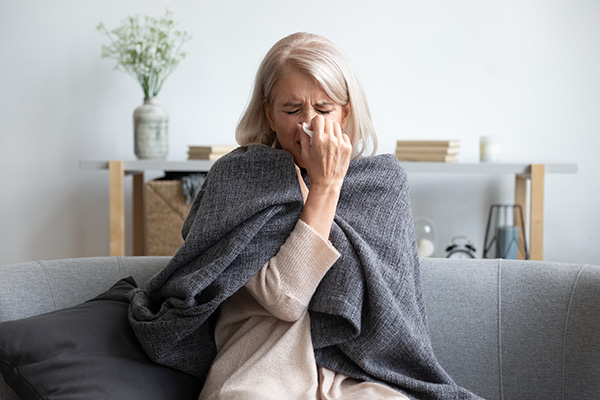Written by Stephen A. Wilson
From his column To Your Health
Haga clic aquí para ver esto en español
 Many have heard the term “tripledemic.” What does it mean?
Many have heard the term “tripledemic.” What does it mean?
“Tripledemic” is the simultaneous presence of an increased number of people infected with either: 1) respiratory syncytial virus (RSV), 2) influenza virus (flu), or 3) COVID-19. The concern is not that all three illnesses occur in one person at the same time, but rather with the number of persons suffering from any of these viruses increasing at the same time. This could result in emergency departments and hospitals becoming overwhelmed and unable to provide adequate levels of care.
So far, the system has been able to handle the increase in RSV and flu cases this season, with COVID-19 cases smoldering in the background.
Nature’s Amazing Protections
Our bodies are in a constant state of defense against foreign invaders—bacteria, viruses, parasites, fungus, and other pathogens—that can make us sick. Every minute, our entire volume of blood, about 5 to 6 liters, is circulated through the body; if exercising, it may circulate 3 to 4 times. The blood itself contains white blood cells designed to fight off pathogens. Each trip through the spleen, lungs, liver, and kidneys help remove these pathogens. Protections outside the bloodstream include: skin (both by its barrier effect and bacteria), antibacterial enzymes in saliva and tears, gut bacteria, stomach acid, mucus linings (that trap small debris and microbes), and cilia in the nose and throat. This beautiful design protects us thousands of times daily.
Masking and social distancing or isolation added extra, less elegant, temporary protections. As those practices waned, people became more routinely exposed to viruses, resulting in more colds and other typical infections this year, especially since part of the immune system is remembering lessons learned from fighting off prior pathogens.
RSV
RSV is a common virus that affects the respiratory system resulting in cold-like symptoms. These include: runny or stuffy nose, sore throat, cough, congestion, sneezing, slight body aches or a mild headache, low-grade fever, and a sense of just feeling unwell. People typically recover in 1 to 2 weeks. More serious cases involve wheezing and trouble with breathing. These persons are at-risk for hospitalization and death. RSV does not have gastrointestinal symptoms.
Most children are exposed to RSV by 2 years of age. As a result, they develop a level of immunity that makes future infections less symptomatic and less likely. However, with COVID-19 precautions, far fewer kids were exposed to RSV, so this year there have been more cases in children up to age 4.
RSV is typically not an issue for kids. For most, it seems like just a bad cold. Very few get sick enough to be hospitalized. People at greatest risk for hospitalization and death are the very young, those over 65, and those with immune problems.
Flu
Flu cases have increased for reasons similar to RSV. Unlike RSV and common cold viruses, flu is associated with sudden onset of symptoms: high fever, severe muscle or body aches (“like I got hit by truck”), headache, fatigue and sometime gastrointestinal symptoms (more often in children than adults). In some adults, flu occurs without a fever, so a sudden onset of the other symptoms could still be flu. Flu is not a bad cold. It is completely different virus. Unlike flu, common cold viruses do not increase your risk for hospitalization or death.
Severe cases of either RSV or flu increase the risk for being hospitalized or dying; RSV—more for kids, especially, those less than 2 years; flu—more for adults, especially those over 65.
Droplets and Surfaces
COVID-19, RSV, and influenza are all contagious respiratory illnesses that result in cough. COVID-19 and flu more often spread by coughing and sneezing of respiratory droplets that then make their way into someone’s mouth, nose, or lungs. They are far less likely to spread through the touching of contaminated surfaces. RSV is the opposite. Spread is caused less through respiratory droplets and more through contaminated surfaces (a child with snotty hands touches a person or object that is then touched by a hand that then touches the eye, nose, or mouth).
Things You Can Do
The best way to decrease spread of these viruses is to practice good general hygiene:
- Wash your hands (20 seconds with soap and water—Don’t forget your thumb!);
- Cough and sneeze into the inner side of your elbow;
- Avoid touching your face (eyes, nose, and mouth are great conduits for pathogens);
- Avoid close contact with sick people;
- If you are attending to someone who is sick, wear a mask;
- Stay home when you are sick; and
- Practice hospitality and courtesy by wearing a mask if you are sick and around others.
Vaccinations Are Important
The best way to decrease risk of hospitalization or death is to be vaccinated. At our hospital, the vast majority of people hospitalized or dead from COVID-19 are unvaccinated.
RSV vaccine (palivizumab) is actually a preventive monoclonal antibody injection for high-risk infants.
Annual flu vaccine is for everyone 6 months of age or older. It is especially beneficial for children less than 2, adults 65 and older, pregnant women, those with higher-risk chronic health disease (e.g., asthma, heart disease, stroke, diabetes, etc.). Like all vaccines, those for flu have potential side effects, none of which is the flu. Current injected flu vaccines cannot cause the flu.
Take precautions to avoid becoming part of the tripledemic.
Dr. Stephen A. Wilson, MD, MPH, FAAFP, is Chair of Family Medicine at Boston University Chobanian and Avedisian School of Medicine, Chief of Family Medicine for Boston Medical Center, President of Boston University Medical Group - Family Physicians, Inc., and a member of the ENC Board of Trustees.
